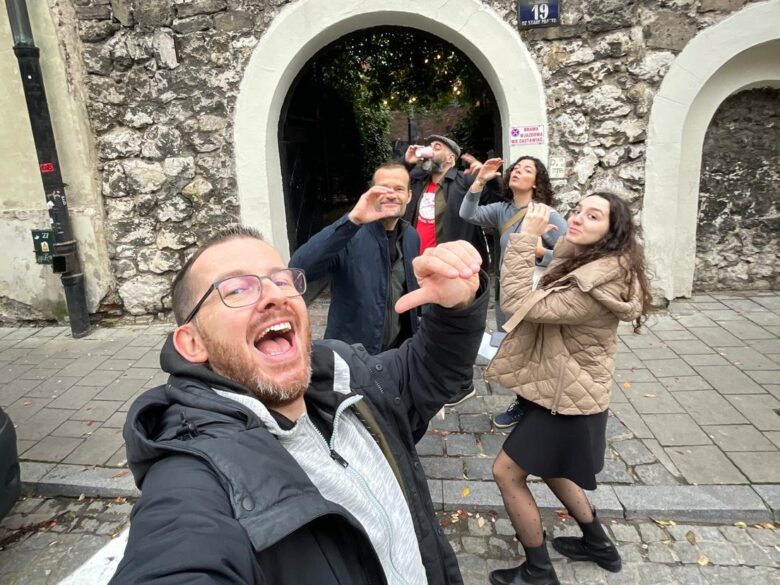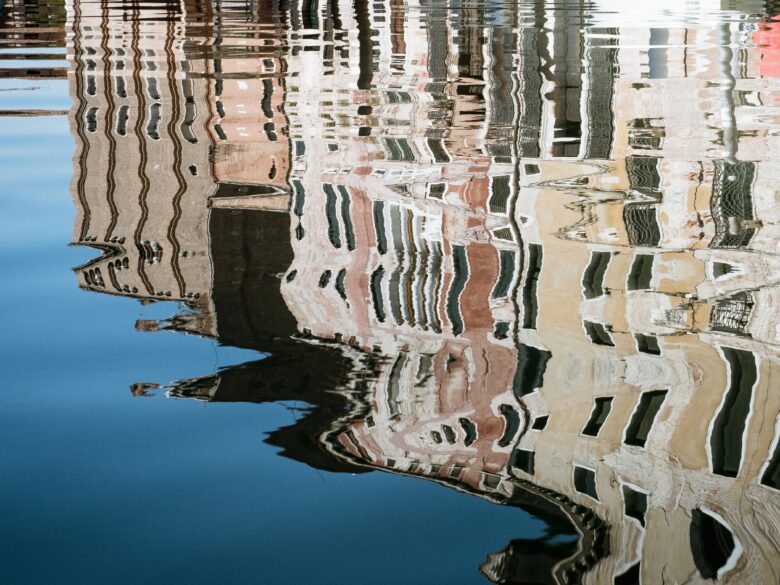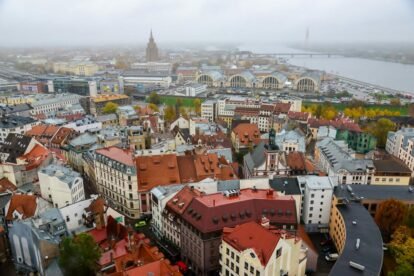
https://www.riga-guide.com/listing/chomsky/Riga as seen from St. Peter’s Church (by Jorge Láscar)
Maybe it’s because summer is approaching and most of us are sorting out our holiday plans, but I’ve started noticing a widespread lack of information and overall tendency to stereotype each time the topic ‘Baltic countries’ come up. I’ve lost track of all the times I heard – or overheard – people being unable to assign the correct name of one of the three states to its appropriate geographical location. Or nonchalantly, changing their mind about visiting one capital or the other, their decision mainly based on whether the figures of a return flight are either two or three.
Once and for all, let’s acknowledge the fact that visiting Latvia is not the same as visiting Estonia or Lithuania, and the other way around. This extends to each one of their capitals, each one of them is worth a trip regardless of the lowest plane fare.
A few weeks ago my article on Tallinn aimed at providing an insight into one the lesser-known faces of that small jewel that is the capital of Estonia; now the time has come to discover Riga, the capital of Latvia, through an itinerary covering a few spots selected by our brilliant locals.
The most populated among the Baltic capitals, Riga is midway between its two ‘sisters’, and not only in terms of geographical location. The city doesn’t directly lie on the seashores like Tallinn, and yet it’s not inland like Vilnius. Riga, the capital of Latvia, located just a few kilometers upstream from the mouth of the Daugava river, and the sea are tightly interconnected.
It’s exactly thanks to its favorable location on the Daugava, a natural trading route linking Northern Europe, the East, and the South, that since the early Middle Ages Riga established itself as a first-importance trading center. Upon becoming a member of the Hanseatic League, and for the centuries to follow, the city – and the rest of Latvia and Estonia also – was ruled by the Baltic German elite (whereas a Polish/Slavic touch characterizes Lithuania and its capital). On the other hand, its people are genetically closer to Lithuanians, while Estonians belong to a totally different family.
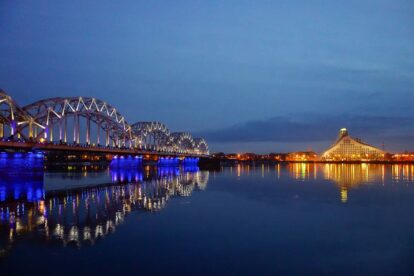
The National Library of Latvia (Castle of Light) – by Artis Rams
The German imprint is clearly still tangible in Riga, despite the strong process of Russification the city experimented after WWII. To this day, Riga still counts the highest percentage of ethnic Russian citizens among the three Baltic capitals, but back in the second half of the 19th century half of its population was German. The aforementioned German and local-mixed merchant bourgeoisie greatly contributed to the economic and cultural prosperity of the Latvian capital. The hundreds of Art Nouveau/Jugendstil buildings of its central district stand as prominent examples of Riga’s wealth and make the city the finest European cluster of buildings shaped in such architectural style. This, added to its well-preserved Medieval architecture, has led UNESCO to inscribe the historical center of Riga on the list of the World Heritage Sites – a characteristic shared with Tallinn and Vilnius.
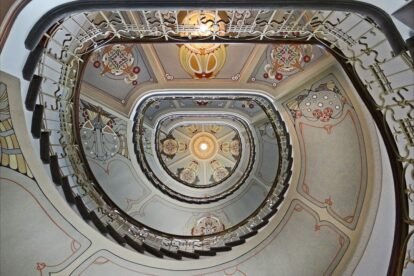
The staircase of an art nouveau building (by Jean-Pierre Dalbéra)
Needless to say, Riga is much more than a bunch of beautifully shaped buildings on the right bank of its river; Riga is offbeat markets and spontaneous events, outskirt forests and palaces. Riga is its left bank with its wooden houses and young-entrepreneurial businesses, blending together the local tradition and craft with the latest cultural trends. I believe that the old Latvian legend mentioned by our Spotter Zaiga fits Riga’s current urban profile very well. The tale has it that once in a hundred years the Devil emerges from the waters of the Daugava and asks if Riga is ready; if he’d ever heard a ‘yes’, the city would inevitably sink into its river. Hence Riga must constantly be built. And that’s what is still happening. Riga is never done or finished, it keeps changing and evolving, and never ceases to surprise its citizens and visitors.
Come discover this unsinkable city with our 48-hour itinerary. As a local, of course.
Day 1: 09:00 – 13:00
It all started with the economic crisis, an event that has hit Latvia as harshly as most European countries. As rents plummeted and businesses started to shut down, a bunch of creatives strove to get the best out of the unlucky circumstances; independent workshops, hip cafes and groovy shops gradually took over a street stretching from central Riga towards its northern district and the first nucleus, of what is now known as the Republic of Miera street, was born.
Now the central axis of a larger creative quarter, Miera street results in a succession of inputs for getting your day off to a good start – beginning with the eponymous Mierā. The cafe sticks to what its name suggests (Mierā meaning ‘in peace’ in Latvian), and the citizens of Riga – among them our Spotter Evija – are suckers for its renowned pancake brunches and excellent breakfasts. Just a few streets south of Miera, Vest’s sleek industrial design and urban vibe have earned it the reputation of one of the coolest venues in town – for morning coffees and evening get-togethers alike.
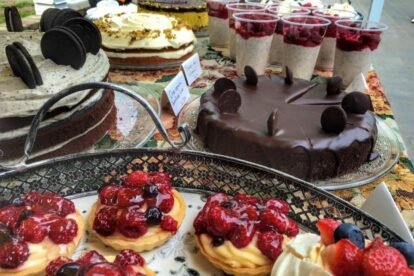
Mierā (by TrAKi MieRĪGA cafe)
A hop, skip, and a jump from Vest is Lokal House, the ultimate mecca for longboarding enthusiasts. On display and for sale are not only a range of funky longboards – handmade in the next door workshop – but also fashionable sportswear, CDs of up-and-coming Riga music bands and a variety of original items in variation to the usual holiday keepsakes. Nearby, the KGB building hosting the Museum of Occupation doesn’t make for the happiest changes in tune, but rather for the aptest institution to learn about the Nazi and the Soviet occupations of Latvia. Absolutely powerful is the guided tour, leading the visitors through the former cells and execution chamber.
Day 1: 13:00 – 19:00
Lunchtime takes you just around the corner, to Mazā Kaņepe: an additional proof that this area of ‘Centrs’ (one of the two neighborhoods in which the Central District of Riga is divided into) is really one of the capital’s places to be; the combo of delicious food (awesome handmade cakes!) and cosily decorated rustic interior will restore your good mood after the visit to the KGB building.
In case you’re up for a longer stroll, walk all the way to the refurbished Bergs Bazaar, a polished series of pedestrian streets built at the end of the 19th century, when covered shopping arcades were all the rage. Among the whole set of shops, cafes and restaurants it is home to, find Andalūzijas Suns for some spicy Tex-Mex; the spacey and light interior, a masterful mix of references from both the industrial and the Mediterranean worlds, is as enjoyable as its outdoor counterpart, where tables find a place around a burbling fountain.
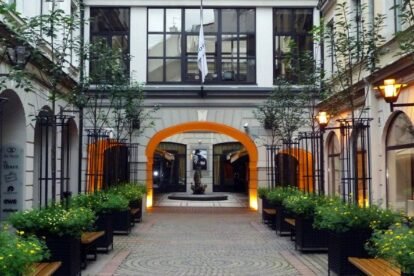
Bergs Bazaar (by Martins Veidemanis)
The Bergs Bazaar is a strategic point of departure for both a more in-depth exploration of Centrs and the nearby Grīziņkalns neighborhood.
Centrs, the 19th century addition beyond the walls of old Riga, is where our itinerary has been running through up to this point; here are the most prominent examples of Art Nouveau architecture and its sub-styles that grace the Baltic capital. Facing Tērbatas street is one of Linda’s most beloved buildings, hosting the Atis Ķēniņš School. Shaped in the Art Nouveau variation defined as ‘Latvian National Romanticism’, it features an unusual cave-like entrance and a geometrically edgy silhouette. Among the many boutiques you will bump into as you gaze around, Paviljons is the showcase of the latest made-in-Latvia pieces of clothing and accessories – a must for fashion victims seeking to expand their wardrobe.
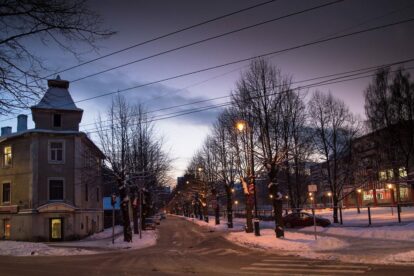
Grīziņkalns (by _TOMS_)
East of Centrs, the neighborhood of Grīziņkalns, once regarded as a dodgy spot to stay away from, is gathering increasing attention thanks to its peaceful streets and rich heritage of 19th-century wooden houses. Most tourists are still unaware of the area, and in case you want to gather some additional information on its history and highlights, Koka Rīga is where you want to head to. Hosted in a former workers’ residence, Koka Rīga works as a museum, an exhibition and information center and as a part-time flea market venue too.
Day 1: 19:00 – 23:00
You kicked off your morning in Miera – do the same with your evening: off the street’s northern portion the renowned Latvian brewery Valmiermuiža has opened its embassy. Stating the obvious, it’s their excellent beer that rules the roost, both in their shop (opened until 22:00) and restaurant. Its traditional Latvian dishes – enriched by a nouvelle-cuisine twist and often featuring beer as one of their ingredients – have conquered the palate of our Spotter Martins as well as of many other inhabitants of Riga. If you have not managed to plan your dinner ahead, Austra is a further, delightful option. The menu of this recently opened restaurant matches its interior: simple, tasteful, sophisticated yet without frills.
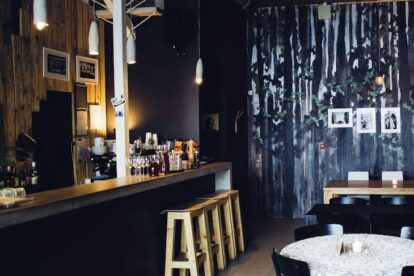
Austra (by Austra)
Valmiermuiža and Austra are respectively close to Labietis and Mākonis. The first is all about beers – and considering you might have dined at Valmiermuiža, it probably makes for the place to aim for. Don’t be intimidated if you are not acquainted with any of their brands: Labietis’ passionate bartenders are always willing to ask for your preference and advise you. The latter, aside from rich meals and coffees, boasts a fine selection of cocktails made of carefully selected spirits and home-made syrups. Whichever you pick, you can bet your bottom dollar you won’t leave disappointed.
Day 1: 23:00 – …
Beer-based dinner at Valmiermuiža, more beers at Labietis… end with a bang at Piens. The nightlife hot spot in Riga is home to one of the most exciting week-night parties, the ‘Wine Wednesdays’ (known as such due to the discounted prices of the grape-made spirit). An additional perk is that you won’t have to walk infinite distances, as Piens is also found just off Miera’s north end.
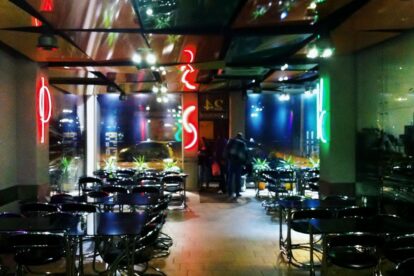
Lauvas Nams – by Evija Kristopane
If by the end of the night there’s more room for food/drinks/anything really, there’s Lauvas Nams down Miera: this legendary cafeteria is open 24/7. Diverse people keep coming and going, depending on the hour – if it’s early in the morning, the crowd might be what you expect: late-nighters searching for the last pit-stop before dozing off in bed, dazzled by its nostalgic 90s neon lights.
Day 2: 09:00 – 13:00
The cobbled streets of Vecrīga (English for Old Riga) hold no secret for Anete. Among her favorite local spots, Konditoreja Vecrīga has become a must among visitors and citizens alike for its sugary delights (mandatory to try are both the sweet cottage cheese Vecrīga Cake and the cream-filled pasty Krēmšnite). On the second floor of the bookshop Globus, Kafka is a snug and peaceful cafe to taste good coffee and tea (Latvian tea, gathered in the local meadows). Not far from there, Bang Bang is both a funky concept store and a cafe serving proper espresso coffee.
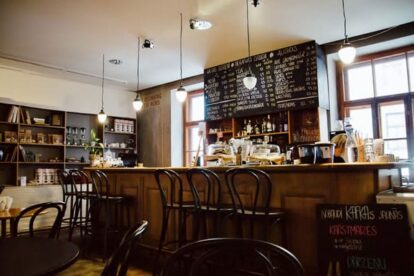
Kafka Kafija (by Anete Bauere)
The southern bit of the city center, bordering the Latgale district, is the location of the lively Riga Central Market, where locals do their daily grocery shopping. A couple of streets away from the original 1930s main building is what is called the Night Market: here’s where farmers sell their goods at friendly prices from 22:00 – 08:00. And since Latgale is just there, don’t miss the legendary Latgales Flea Market; heaven for fearless treasure hunters. On the riverfront, a cluster of former 19th-century brick warehouses, now refurbished, constitute the Spīķeri creative district; grouping together high-end as well as more underground stores, cinemas, exhibition halls, and restaurants, Spīķeri is the typical example of well-achieved post-industrial conversion.
Day 2: 13:00 – 19:00
Pārdaugava is the area beyond the river, Riga’s left bank (the Latvian name literally translates as ‘over Daugava’). The historical district of Āgenskalns, overlooking Old Riga, was built from the end of the 19th century and has retained many of its charming old wooden houses. The last years have seen an extensive makeover of its buildings, but Nometņu and the surrounding streets (such as Lapu) have been ‘spared’ – for the moment – from the renovation. Particularly rich in spots and attractions is the architecturally varied Nometņu.
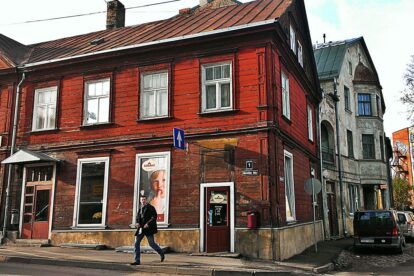
Kūkdari – by Martins Veidemanis
Starting from its northern end, meet Kūkdari and Fazenda; the first is among the best patisseries in town and serves an outrageously good selection of cakes, biscuits, and cookies. The second, a warmly decorated cafe/restaurant with lunches good enough to brighten even the darkest of days, feels like a Latvian grandma’s house. Proceeding southward you’ll spot the red brick building of the Āgenskalns Market and its outdoor flower stall at a crossroad; turn right and feel in peace with the world at the Kobe Garden; formerly known as Meteors Garden. It was named after the Japanese imperial city that is slowly turning into a traditional Japanese-style garden.
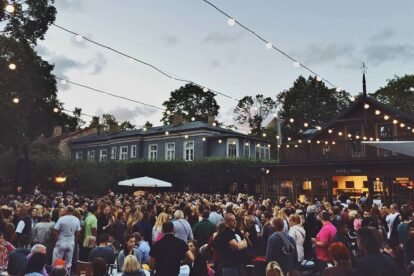
Kalnciema Kvartāls (by Anete Bauer)
Once you feel the energy flowing back to the body, it’s time for Kalnciema Kvartāls. Unlike most of those in Nometņu, the houses of this quarter (kvartāls in Latvian) have been restored to their original look and colours; also, the number of events held in Kalnciema has made the area a busy hangout for hundreds of locals and visitors. From May till September, Thursday nights are devoted to open air concerts and a food & craft market, while every Saturday from 10:00 – 16:00 another market takes place.
Day 2: 19:00 – 23:00
In Vecrīga, take a seat at the restaurant regarded as the first to make use of Latvian rural products – be it fish and meat, vegetables and fruit, milk and beer – in a contemporary, innovative fashion. Valtera Restorāns (this is its name) looks like a countryside house, its strong points being its “simplicity and sincerity. Without glamour and snobbery’, as described by its chef Valters Zirdziņš. Otherwise, Stargorod makes for a tempting option for the carnivorous; the menu, mostly featuring dishes from the Czech culinary tradition, is meat-based (every evening a whole animal is prepared on the grill), rich in both calories and taste. An additional perk: Stargorod is also a brewpub, meaning they produce beer on the very spot.
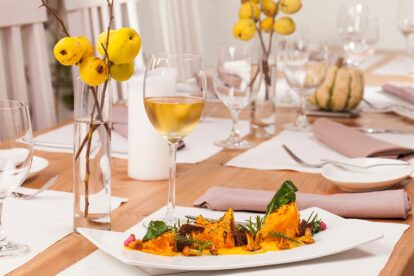
Valtera Restorāns (by Valtera Restorāns)
The two bars called Ezītis Miglā are just a short walk from both Valtera and Stargorod. Both in Old Riga, the older one is tinier than the new one, but the vibe and the concept are the same: cheap drinks and spirits, friendly atmosphere, music till late night/early morning. To the east, just a couple of streets away from Centrs, the ex glazier shop Chomsky appeals to a cosmopolitan, fashionable clientele. The aesthetically, old-school decorated space often hosts events such as lectures, gigs, artistic performances and movie nights.
Day 2: 23:00 – …
Away from the hustle and bustle of sometimes-too-touristy Old Riga, Vieta (place in English) is a self-defined ‘culture bar’. Indeed, it does host exhibitions, artistic theatrical performances and so forth… but ‘culture’ embraces a wide spectrum of activities, so it’s not uncommon to stumble upon a cool DJ set by some upcoming Latvian musician and producer.
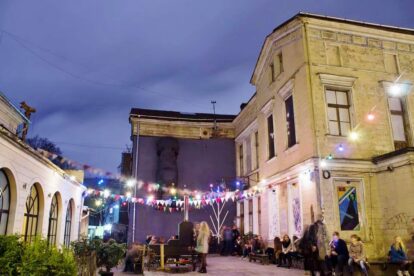
Kaņepes Kultūras centrs (by Kaņepes Kultūras centrs)
Worth checking out is also Kaņepes Kultūras centers: it’s a block away from Vieta. As the name suggests, the place is a polyvalent center where eventually everyone in Riga has ended up at least once in their life. Sit on the terrace, dance in the yard, sip a drink… on Saturdays Kanepe’s Culture Centre is open until 05:00, with people coming and going… in the end, they have to: as the legend tells, Riga shall last as long as it’s not done and ready.
More? Check our Riga blog or app!

![10 Unique Flea Markets in Europe [2024 Update!]](https://www.spottedbylocals.com/wp-content/uploads/midnightbazar-munich-by-ayla-amschlinger.jpg)
